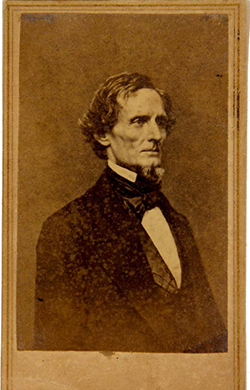
Please send all Checks and Money orders to :
Dave Taylor P.O. Box 87 Sylvania, OH 43560
419-842-1863
Click Here to E-mail Us!
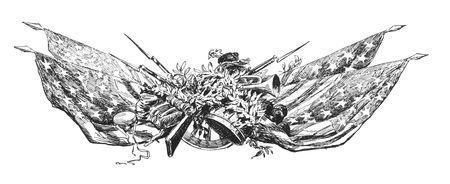
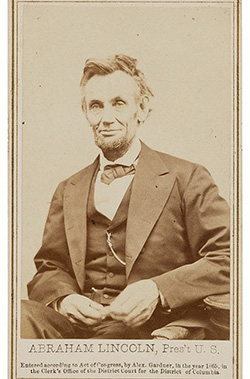
18-03-01
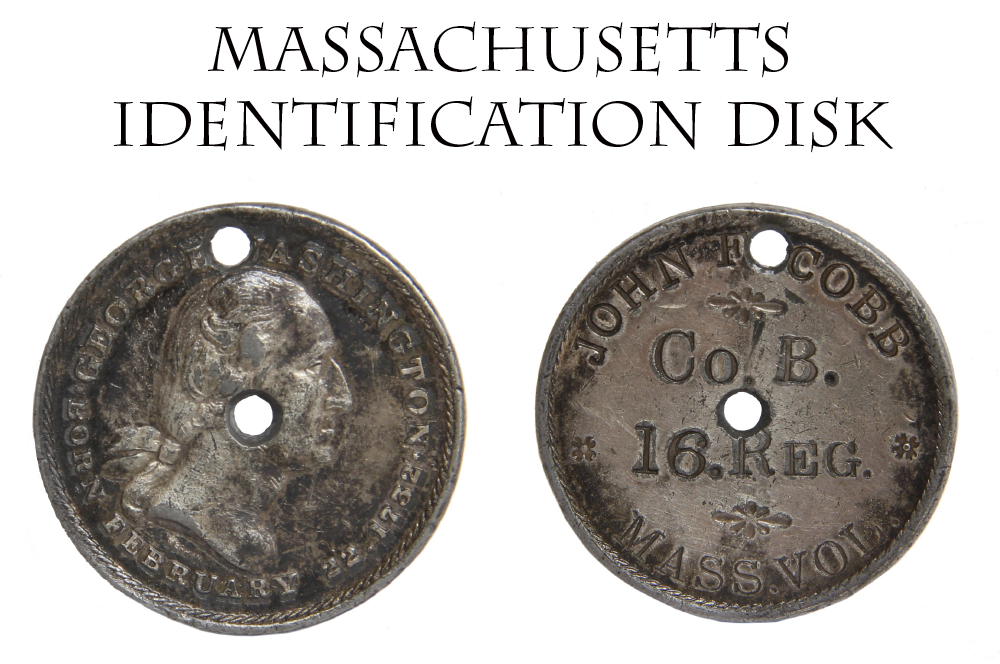
18-04-00.. 18-04-00..16th MASSACHUSETTS IDENTIFICATION DISK BAYONETS AT BULL RUN!…
Washington portrait bust identification disk belonging to John F. Cobb, Co. B. 16th Massachusetts Volunteers. Cobb was a 20 year-old bootmaker when he enlisted and mustered into Co. B of the 16th Mass on 8/11/62. During Cobbs service the regiment was part of the 3rd Corps, Army of the Potomac. At Second Bull Run they were part of Grovers Brigade, which, in one of the few successes of the day, launched a bayonet attack against the famous railroad embankment, breaking two Confederate lines in fierce hand-to-hand fighting before a lack of support made it necessary to pull back. The assault cost the regiment some 21 killed and 78 wounded. At Fredericksburg they saw action again, losing another 2 killed and 15 wounded, according to Civil War Data. Cobb was discharged for disability at Falmouth, Va., on 4/1/63, which was a lucky thing for him, since the unit went on to further heavy fighting at Chancellorsville and Gettysburg soon after. This has a very clear stamping of name and unit and lots of detail on the Washington bust, with his name and birth date still legible. Cobb added a second suspension hole dead center to the disk. I dont know what the purpose was, but he may have mounted it on something later. A good solid example of a scarce pattern disc, and from a unit that saw some serious action. Battle Worn!
$795.00
Sold
Call us @ 419-842-1863

18-04-01…Remington 1863 Percussion “Zouave Rifle”…
One of the most attractive rifles ever produced for the US army, and their use is still a mystery. It is known that Remington produced some 12,501 of them, most in 1863 and 1864. None are known to have been issued to troops in the field. Handsomely furnished with brass mounts, including the patch box, these were clearly patterned on the earlier rifles descended from the M1841 Mississippi rifle and the 1855 Harpers Ferry two band rifle. This one is overall VG+ condition fresh from a Michigan estate auction. Lots of blue-turned-plum brown barrel color. Muted, age tones to the brass. Clear 1863 and Remington maker stamp with U.S. and eagle on the lockplate. The breech of the barrel shows some corrosion from firing (the fulminate of mercury in the percussion caps takes its toll.) The last two digits of the barrel date are obscured. The barrel proofs are legible as is the “Steel” marking and barrel inspector initials on the side. Bore is excellent and shiny. The rear sight is the correct short range 2 leaf type. The left side of the stock on the side at the breech is cracked and was repaired to keep it usable. A small pin is visible at the top and the wood and metal show the matrix marks of a vise used in the repair. Mechanically very good. Patch box functional. springs and swivels are all original and in place. All original except for a properly made replacement ramrod. Nice even dark tone to the wood. Bayonet lug in place at the muzzle for the saber bayonet. One of the most attractive Civil War rifles at a decent price
… $1,250.00
Call us @ 419-842-1863
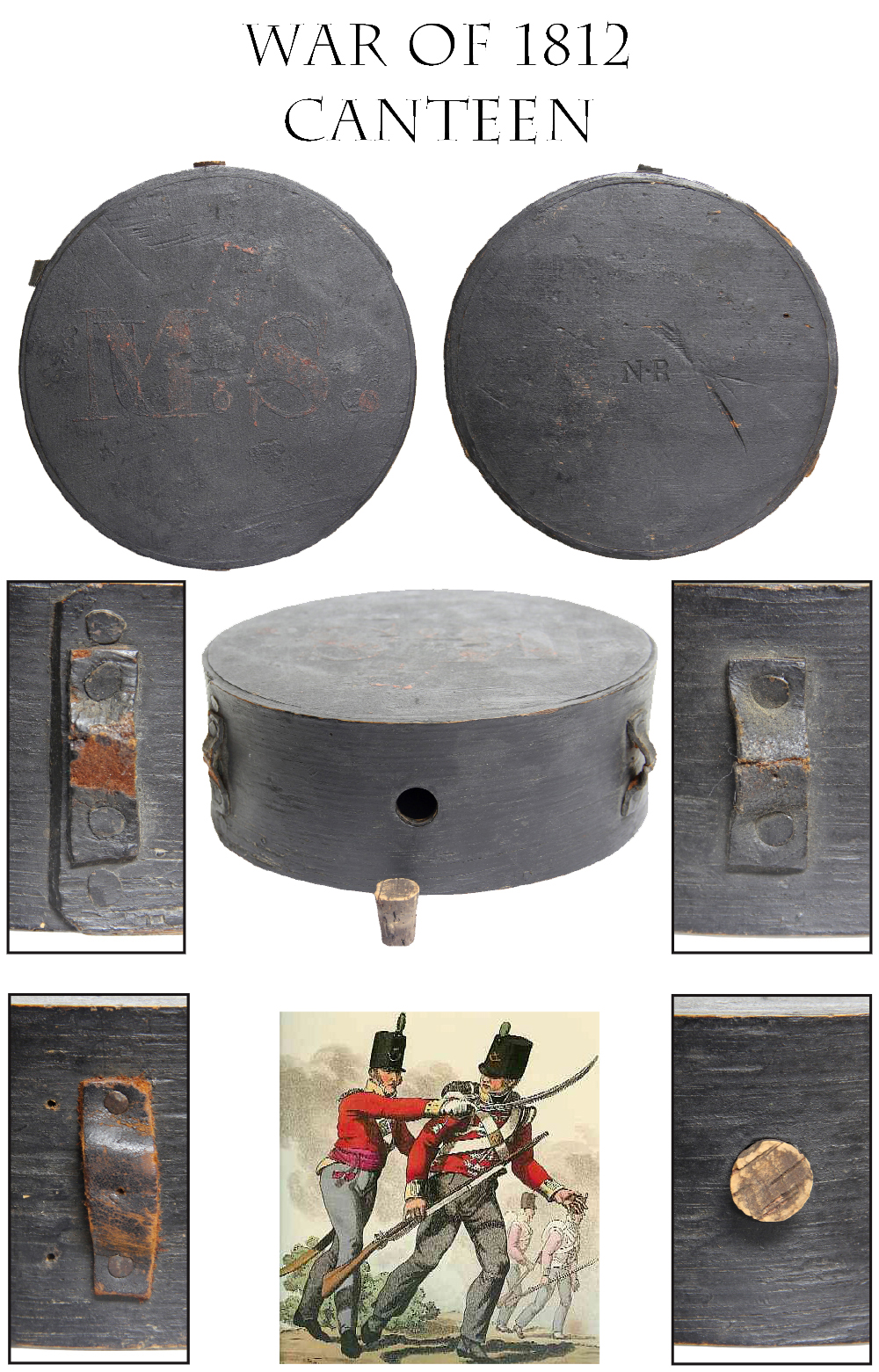
18-04-02 … REGULATION WAR OF 1812 U.S. CHEESEBOX CANTEEN …
This pattern of canteen was produced under contracts from the US government in early 1812 to equip auxiliary detached militia from the various states who would serve under US command. The single-rim form was a familiar one to New England makers and was supplied to the US government usually in black with a US painted on the front. The maker’s initials, “NR” are branded on the back of this one, and two of the original leather loops for the sling survive, as well as an old replacement for the third. At some point many of these canteens were transferred from the US government to the state of Massachusetts and repainted in a bluish-green with a red “MS” on the front, over the original “US.” In this case, the original “US” can be seen underneath. No one knows when the canteens made their way into state hands. Some feel the state acquired them as surplus from the federal government, but there is equally strong opinion that it happened between 1812 and 1815. See O’Donnell’s book on canteens for the story. This is a very nice example of a recognized US military canteen and displays really well with 1812-era material. I even include a cork- vintage unknown. I can sell this for the same price I was getting six years ago…. $595.00 Sold
Call us @ 419-842-1863
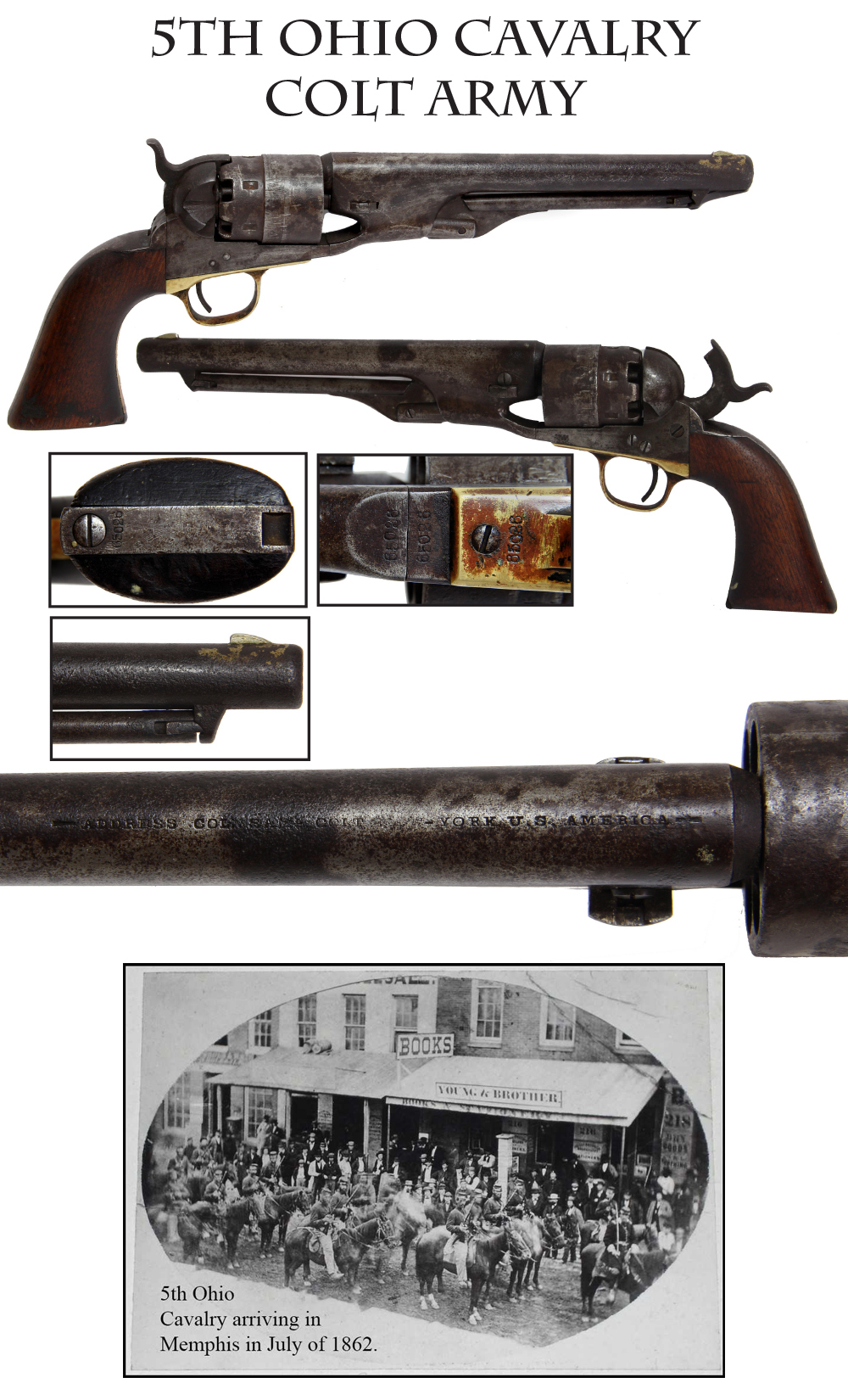
18-04-03…IDENTIFIED 5th OHIO CAVALRY COLT ARMY REVOLVER: This is the Real Deal…
a dead-on DIRECT HIT by serial number matching the US Army ordnance records. This Model 1860 Colt Army Revolver bears serial number 65,026. US ordnance records show this revolver was issued to Sergt. Stephen C. Conrey Co. “I” 5th Ohio Cavalry in July 1862. No doubt about it… a direct hit. Conrey served with the 5th OVC from October 1861 to November 1864. The revolver is a solid old War-Horse showing much age. Condition is good to very good. All serial numbers match except the cylinder. The condition of the cylinder matches the rest of the gun so we can bet it has been with the gun since the 1860s. Metal shows much use and age with moderate pitting on the right side of the barrel and numerous scratches and gouges on the cylinder. Some cylinder scene remains… but is largely obliterated with the scars. Firm name is visible on top of the barrel. Grips are good. Mechanically fine. 100% original and 100% complete. The 5th OVC was extremely active in the western theatre. CW data lists 67 data points where the regiment, or elements of it, were not only engaged but suffered some kind of loss, which gives an idea of how much campaigning they did. They also list one officer and twenty-six enlisted men killed or mortally wounded, which is significant for a cavalry regiment. Mostly serving as part of the armies and departments of Tennessee and Mississippi, the regiment recruited in late 1861 and took the field in February 1862, reporting to General Sherman in Kentucky. It moved down to Pittsburg Landing on March 15 and saw action the very next day on an expedition just five miles in front of Shiloh chapel, and then saw more action at Crumps Landing just two days before the Battle of Shiloh, where it also served under fire. The regiment then took part in the march on Corinth and parts of it fought at Metamora and Davis’s Mills. In April 1863 it saw action at Memphis and a month later at Coldwater, Miss. At Panola, outnumbered, it charged through a surrounding ring of Confederates and broke through. At Clear Creek, Alabama, Gen. Osterhaus complimented it after eight days of almost constant fighting. In 1864 it took part in the Sherman’s March to the Sea, adding to its list of numerous small unit actions and seeing its last significant fight at Fayetteville in March 1865, where it lost several killed and wounded, before it was finally mustered out in October. Truly “identified” firearms from the Civil War are extremely scarce and very desirable. Here is one with a good full war history in a tough Ohio Cavalry regiment.
$2,950.00
Sold
Call us @ 419-842-1863

18-04-04 … COLT GUN POWDER FLASK FOR COLT REVOLVING RIFLE…
This handsome flask is illustrated in the Colt Wholesale Price List of 1860. Made by the American Flask and Cap, Co., this is the famous “Coat of Arms” pattern and came in a number of variations in suspension rings, finish, etc. This one preserves a lot of its original dark brown lacquer finish with just some minor rubbing on the high spots. There is a minor dent on the reverse. The side loops and suspension rings are firmly in place. The charger uses a conventional top mounted thumb-piece and spring, along with a marked, three-position measuring spout. The tension spring is broken (see photo) but I will leave that for you to replace. (Rob a spring off a ratty twenty dollar zink flask and you are in business.) The brass shows an ultra attractive unmolested patina mixed with traces of gilt. A nice Colt percussion accoutrement proper to display with a Colt revolving rifle. 7 1/2 inches overall length including spout. Priced to cause no pain… and will bring another hundred dollars when you replace the spring…
$395.00
Sold
Call us @ 419-842-1863

18-04-05…T-Shaped Cone Wrench …
Steel T-handle cone wrench. Likely for a cased shotgun or rifle, the metal is smooth and shows faded original blue now turned deep gray, mixed with some lighter silver areas.
$60.00
Call us @ 419-842-1863

18-04-06..BATTLE OF THE ALAMO ERA REGIMENTAL SNARE DRUM:
A handsome infantry size drum bearing the label of “… DRUMS… Manufactured and for sale by Porter Blanchard Concord N.H. 1831”. The body of the label is printed. The date of 1831 is written in manuscript ink. Perfect to display with Alamo (1836), or Republic of Texas , or Mexican War era artifacts. Overall VG. Body is very sound. Ropes are replaced and need to be tightened. Rims are solid. Eight original leather tighteners are in place two more are included and loose. The heads show much age but were likely replaced late in the 1800s. Same is true of the rims. They show wear to the rope holes and to the red paint.
The body is plain and unpainted,. Very handsome. The ends of the shell were overlapp
e
d and fastened with two rows of small drum nails. The original scribe line for the inside line is still visible. The lower rim is slotted for a snare, which is no longer present. Like most, it was probably a friction fit across the bottom head, drawn tight at the same time as the heads by adjusting the rope. Ttypical of drums carried by company musicians, the “field music” of regular army and state units from the 1830s to the Civil War. Great display item.
$795.00
Sold
Call us @ 419-842-1863
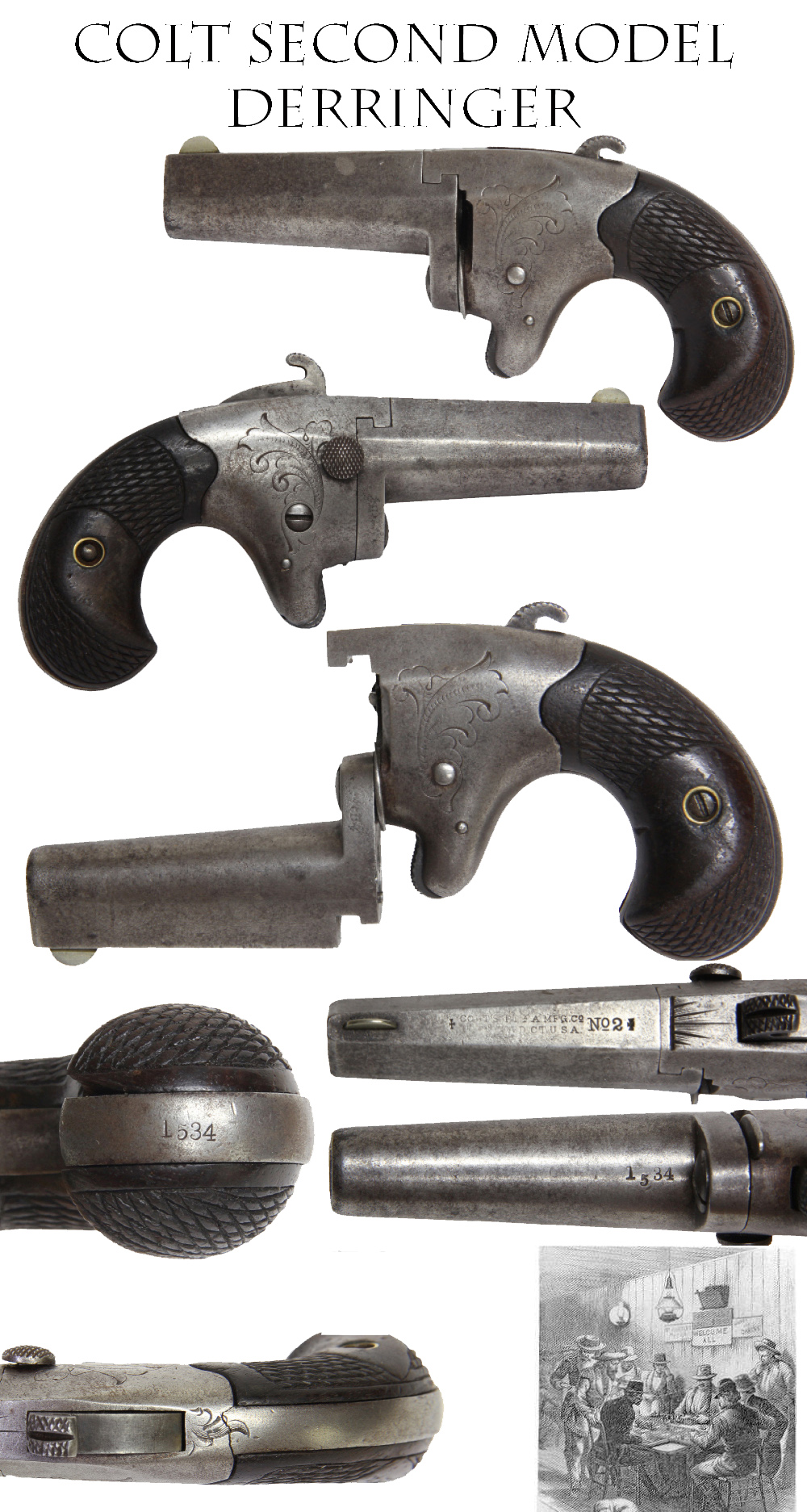
18-04-07…COLT SECOND MODEL DERRINGER …
Made from about 1870 to 1890, this .41 caliber was a handy vest pocket gun. The walnut grips on ours are good, showing deep checkering and just the slightest of wear around screwplate on the left. The fit to the metal is tight. The scroll engraving shows just the lightest of wear, also on the right, and metal is a smooth, dull silver overall with some hints of gray and a bit of brown on the barrel. Matching serial number 1534 on the butt and underside of the barrel. Correct Colt barrel markings on the top, just a tad light on the left, but with a very visible No 2 at right and sunrays just aft, at the top of the receiver, and another bit of scroll engraving just behind the hammerthis was about the only Colt that indulged in engraved details like this. A nice early western back-up piece that might be a card-players or travelers ace-in-the-hole.
$895.00
zxgjjvx
Call us @ 419-842-1863

Call us @ 419-842-1863
18-04-08… RIFLE OR MUSKET MUSKET TOOL DATED 1863:
This is a new variant on me. Looks something like an English Enfield tool, but the markings have a German or Austrian flavor. Solidly machined and nicely marked including 1863 date clearly stamped in the steel. Nipple wrench designed to fit a large musket nipple. My guess is that it fits an Austrian or Bavarian import rifle. My ignorance gives you the edge. Nice with the firm 1863 manufacture date.
$125.00
18-04-09…U.S. BOX PLATE .. Regulation Civil War oval US plate of stamped brass with a solder-filled back and two loops to secure it to the flap of an infantry cartridge box. These served a practical function in keeping the box flap down if the soldier forgot to relatch it in the heat of battle, but were also decorative. Polishing them was a standard chore for soldiers before regimental inspections. This one shows dings on the face and edge from actual use and a darkish patina from age. The reverse shows some corrosion to the lead and rust to the iron loops indicating it might be an early battlefield pick-up. There is a bit of light carving in the center of the reverse that I have been unable to decipher, though one element seems to be a script “S”
$190.00
Sold
Call us @ 419-842-1863
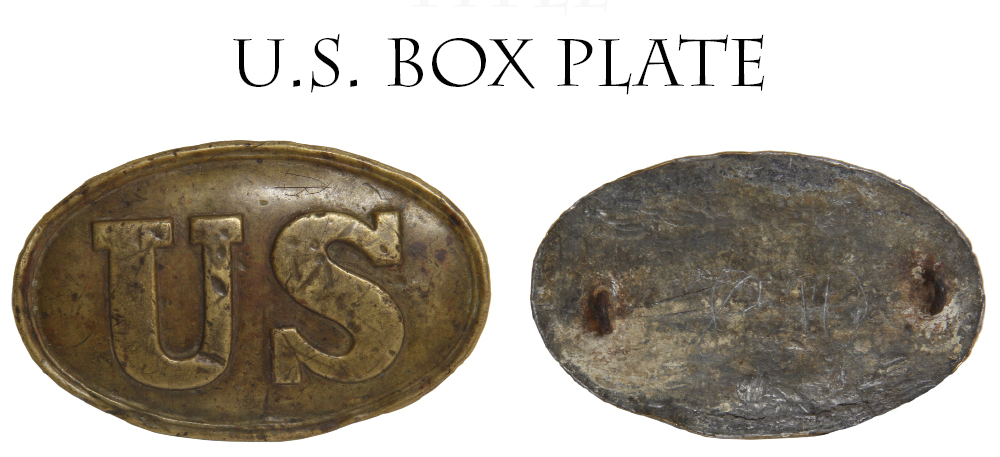
18-04-10 …IDENTIFIED 124th PENNSYLVANIA SOLDIER’S CIVIL WAR FORAGE CAP BATTLE OF ANTIETAM:
There are probably very few of us left who remember collector dealer Anthony “Tony” Tafel from Newark, Delaware. He was very active in buying and selling in the 1960s and 1970s. I loved receiving his mimeographed mail order sale lists 40 plus years ago. This cap was once part of his collection and comes with a letter from him detailing the history. His typed letter reads in part: “…forage cap bearing the company letter “E” and the cloth of crown thereunder damaged and partially repaired…. purchased by me in the late 1960s from family relatives … did indeed belong to and was the property of William Townsend Company “E” 124th Pennsylvania Volunteers. Said forage cap being part of my personal collection from time of purchase until 1978….” Also written on the back of the letter is the following: “Purchased from family by Anthony Tafel. Sold from Tafel to George Lower. Traded from George Lower to Bill Paulaskas. From Bill Paulaskas to Steve Saathoff”. I remember all these guys like it was yesterday. Many of us bought stuff from George Lower The Gettysburg Sutler. Anyway, Steve passed away a few years ago. His widow sent the extensive collection to auction. I bought this cap at the auction. Private Townsend hailed from Chester Twp. Pennsylvania. He enlisted in the 124th in August of 1862 and served the full 9 month term with them until the regiment mustered out May 16th 1863. The following is taken from The Union Army… Under the call of July, 1862, the 124th regiment was recruited in Chester and Delaware counties, ren- dezvoused at Camp Curtin, and on Aug. 12 was ordered to Washington, where it was mustered into the U. S. service for a nine months’ term. On Sept 7, it was sent to Rockville Md., and attached to the 1st brigade, 1st division, 12th corps, which started two days later for South Mountain and Antietam. In the battle of Antietam it was ordered to reinforce Gen. Hooker on the right of the line and was soon in action, losing 50 in killed and wounded. It then went into camp at Pleasant valley, where it was transferred to the brigade under Gen. Kane and on Oct. 30, occupied Loudoun heights. It was next ordered to the support of the troops engaged at Fredericksburg, but arrived too late for the battle. The regiment then encamped at Fairfax Station, joined in the “Mud March,” and returned to camp near Stafford Court House. On April 27, 1863, as part of Geary’s division, 12th corps the regiment started for Chancellorsville, where it was posted on the right and was closely engaged on May 2. It then returned to camp and remained there until the expiration of its term of service, being mustered out at Harrisburg on May 16-17. 1863. Forage caps are the quintessential piece of Civil War headgear. You dont have to be a collector or even a history student to recognize one a hundred yards off. Introduced in the 1850s as the cap for fatigue wear, they became the standard issue headgear for just about every Union soldier in every branch of service, particularly in the eastern theatre of war. This one shows some significant mothing on the lower front of the top, which has been backed by a small piece of blue cloth. The company letter E is in place on the lower front edge. The cap certainly shows the signs of real field wear. There are some other scattered pencil-point sized moth nips on the top of the crown and a couple on each side of the center seam on the back, but nothing too hideous. The chinstrap, side buttons and buckle are in place. The interior shows about 80 percent of the polished cotton lining, but there is a piece out on the wearers left rear and some tears and a small piece gone inside the crown. A partial L.J. & I. Phillips label is still in place in the center of the crown. The cap shows a little bit of fading from real battlefield wear at Antietam and Chancellorsville, as well as dirt and dust from years of storage. A cap that was really there.
$2,250.00
Sold
Call us @ 419-842-1863
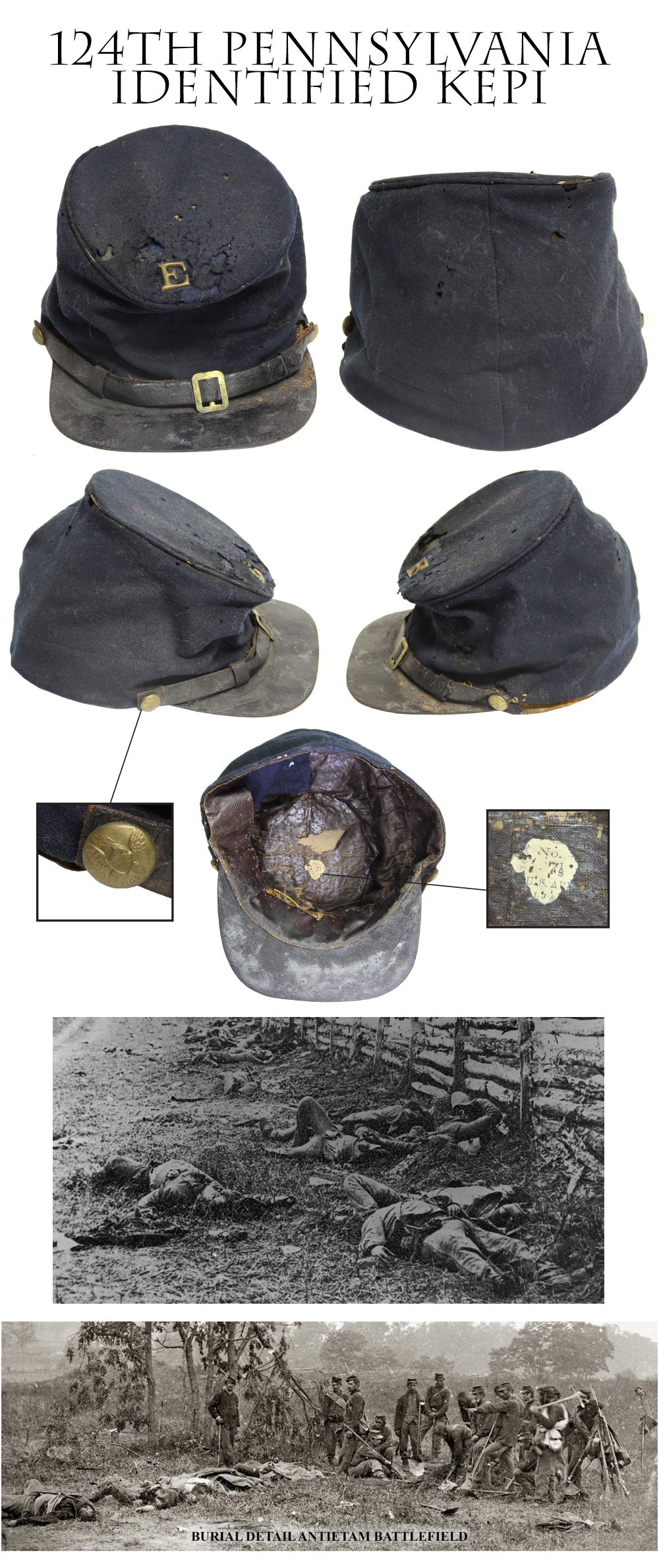
18-04-11…VERY HANDSOME FRENCH IMPORT UNION OFFICERS SWORD …
Non-regulation staff and field officers sword with a deeply cast and chased brass hilt covered with raised foliate designs and European version of an eagle with US shield on its chest superimposed on a trophy of cannons and flags in the counterguard. French maker and inspector marks are clearly visible on the outside of the guard, the base of the blade and the blade spine. These swords were a combination of French regulation patterns and were sometimes called sabres de Fantasie in France. This has a full sharkskin grip with binding wire intact, and the leather washer in place on the underside of the guard. The blade is etched with floral motifs as well as a U.S. and E Pluribus Unum in a floral swirl. The etching is vivid the blade is largely in the bright with just some light scattered graying. The brass elements have a medium aged patina. The scabbard follows the lines of a conventional US 1850 pattern with a steel body and brass mounts that are lightly decorated on their upper and lower edges. The scabbard shows some light faded blue, but shows mostly as a subdued bluish gray. There is a very minor age dent in the scabbard on the outboard side between the upper mounts and two small dings on the drag on the same side. The deeply cast motifs on the hilt make this a very showy sword. A lot of sword for very little money
$895.00 zzxxgvvzz
Sold
Call us @ 419-842-1863

18-04-12…COMPLETE SMOOTH SIDED UNION ARMY CANTEEN WITH A SOLDIERS STENCILED ID …
The stopper chain on this canteen identifies it as a product of the New York Depot. It has a full, gray-tan wool cover with no holes and the full cloth shoulder sling. The sling is solid, with just a couple of stains and points of abrasion from the side brackets. Stenciled in black on one side is J. MC. C / 9 It is impossible to know now whether the 9 is the soldiers rack number or a regimental designation, but the marking shows well and indicates the canteen was actually issued and carried by a soldier. The canteen was an indispensable piece of gear for the soldier in the field and a basic element in a Civil War collection. This is one of the nicer issued examples I have seen lately.
$395.00
Sold
Call us @ 419-842-1863

18-04-13..CARBINE SOCKET … Civil War cavalrymen typically carried their carbines hanging from wide shoulder slings when mounted. The sling bore the weight of the gun, but it was necessary to keep the barrel from flailing around when the horse was moving. This was accomplished by shoving the barrel of the carbine into one of these sockets that was buckled to the saddle low down on the riders right side. This one is the standard Civil War pattern, made and marked by Metzger of Philadelphia, one of the large suppliers of leather gear to the US government. This one is in top notch condition, just about new, with lots of finish left on the leather and the original black japanning on the buckle. A small, but essential piece of cavalry gear. The cheapest minty example on the market… $59.00
Sold
Call us @ 419-842-1863
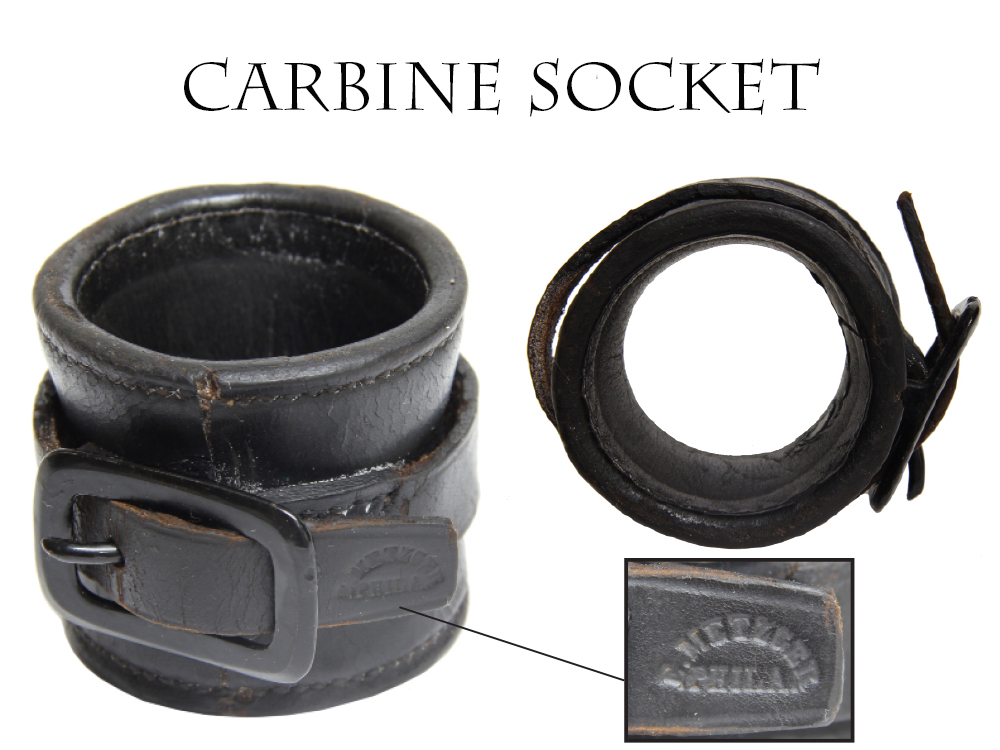
18-04-14 … CARBINE CARTRIDGE BOX …
Regulation issue Union cavalry carbine cartridge box made and marked on the lower front by J. Davy of Newark, NJ. These boxes replaced some of the early war boxes that were designed to accompany specific carbines. By changing the configuration of an interior wood block bored out to take some twenty rounds, the box could be used with a variety of cartridges. This one lacks the block but is a very nice example of the type. They were intended to be carried on the saber belt, but some extent examples and at least one contemporary drawing show that troopers often mounted them on their carbine slings. The loop and buckle arrangement show the box could be used with a shoulder sling as well, but they do not seem to have been issued or carried that way and the very late war boxes omit the sling buckles. This one has decent finish. The latch tab, side ears, belt loops and inner tool pouch and tab are all in place. The Davy mark is very legible. A very nice example of standard cavalry accoutrement priced like the old days… $250.00
Sold
Call us @ 419-842-1863

18-04-15… MINTY HARDEE HAT …
The army dress hat was first introduced in 1855 as regulation for the new regiments of cavalry, but was adopted army-wide just a couple of years later. Turned up on one side by regulation and adorned with a branch of service insignia, colored hat cord, brass side eagle and plume, they were a striking piece of headgear. Some soldiers hated them as tall, stiff and ungainly; others quickly saw their potential as slouch hats for field wear. Along with the forage cap, they were the typical headgear of the Union army. This one would be hard to improve upon for condition. It is near mint. The brim is flat, just as issued and the crown has not been crushed down or pinched in by careless handling. The tall, original sweatband is in place and secure. The underside of the crown retains its black stiffener with the makers logo and U.S. Army. / No. 4 size marking blindstamped in it and very legible. A collector added an infantry hat cord and an infantry hunting horn to it. I have left them in place and selling it as it came to me. The horn could come off to show the hat plain, as I kind of prefer, or you could change the insignia to cavalry and up the price by a thousand dollars. Old collectors remembered these being available in stacks at surplus dealers, but those days are long gone. Its tough to find one in any sort of condition now, and this one would be tough to beat in any circumstances. When John Ockerbloom sold his collection through Amoskeag Auction a decade or so ago these mint Hardee Hats were hammered down for as much as TEN THOUSAND DOLLARS EACH… the buyer being the US Army! I was there and we were incredulous. Here is a BEST example priced very realistically at… $4,500.00 me&z
Sold
Call us @ 419-842-1863
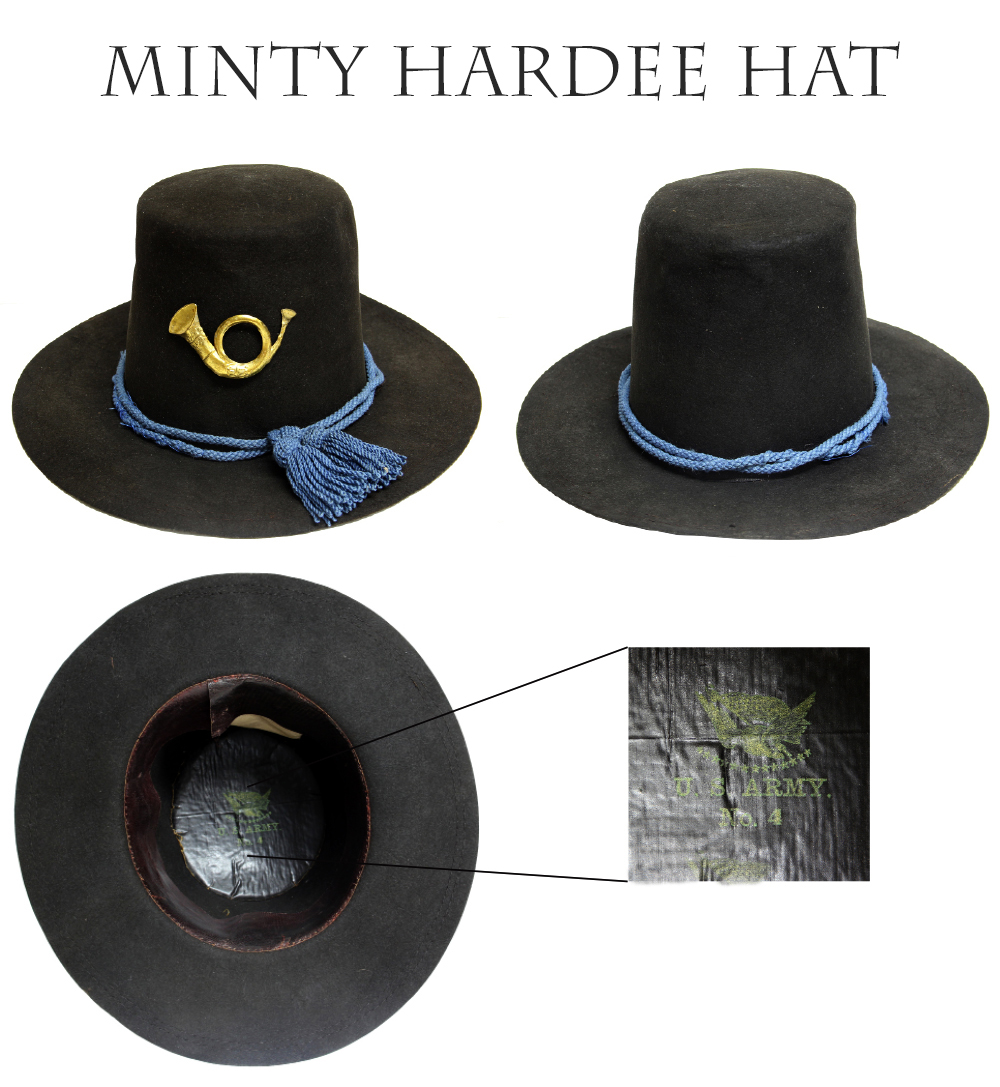
18-04-16 … REGULATION HOLSTER FOR AN ARMY REVOLVER …
Here is the quintessential Civil War issue revolver holster. The full flap is secured by a riveted and sewn latch tab that fastens over a brass stud. The belt loop is wide so as not to pinch the belt from the weight of the gun and is secured at the bottom with stitching and three rivets. The toe plug is in place. The leather has just about all of its black finish with crackling and crazing overall, but just some minor loss along the of the flap from flexing as is normal. This pattern was designed to carry the Colt Army .44 revolver or the Remington in the conventional butt-forward position on the trooper’s right side. Many more of the the pistols survive than the holsters and it’s hard to find them in any sort of condition. This one is quite nice…. $450.00 Sold
Call us @ 419-842-1863
Layaways are Welcome
Need to split your order into multiple payments? No problem! A simple 20% earnest money deposit will hold your item for you.-acf
You can then pay it off in easy installments that fit your budget.
Read Terms Here
Items to Sell? Contact Us
I am always interested in buying ANYTHING from the American Civil War… Guns, Swords, Civil War Muskets, Knives, Uniforms, Flags, Medals, Badges, Diaries, Letters, Autographs, Buttons, photographs, tintypes, daguerreotypes, Insignia, Camp Items, Battlefield Relics, canteens, Drums, Etc… Call 419-842-1863 and ask for Dave Taylor.

